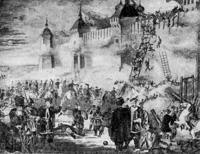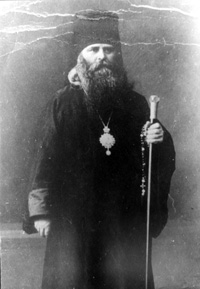History
 The monastery was founded in 1397 by the Moscow monk Kirill, a contemporary and a disciple of St. Sergey Radonezhsky. The icon “Appearance of the Virgin to St. Kirill at the Simonov Monastery” (the late 17th- early 18th centuries) reflects an important moment of the saint’s life: a place for the future monastery was miraculously indicated to him.
The monastery was founded in 1397 by the Moscow monk Kirill, a contemporary and a disciple of St. Sergey Radonezhsky. The icon “Appearance of the Virgin to St. Kirill at the Simonov Monastery” (the late 17th- early 18th centuries) reflects an important moment of the saint’s life: a place for the future monastery was miraculously indicated to him.
St. Kirill lived for 30 years on the shore of Lake Siverskoye and died in 1427 at the age of 90. He was canonized already in the 15th century. A chasuble, a fur-coat, a knitted cap, scoops with cases, a leather belt with a bag and a wooden staff belonging to him are not only unique exhibits but true sacred objects. A huge wooden cross which is more than 2 metres high has been made, according to the legend, by the founder of the monastery himself.
But St. Kirill wielded not only an axe, but a skilful pen as well. Being an all-round and well-educated person and an experienced copyist he formed the basis of one of the richest monastery library. Manuscripts and printed books of the 17th-19th centuries decorated with embossed leather bindings, stamped and engraved covers are displayed in the exhibition.
 In the 16th-17th centuries the Kirillo-Belozersky monastery was of the most esteemed in Russia. Receiving donations of many princes and tsars (including Basil III, Ivan the Terrible, the Romanovs) it became the treasury of the greatest artistic values. Remarkable Royal Doors donated by the tsar Michael Fedorovich Romanov are a wonderful work of Moscow icon painters and silversmiths. Tsars’ charters exempted the monastery from some duties. The Charter of the tsar Alexei Mikhailovich giving the right to duty-free fishing is a magnificent literary monument of the 17th century.
In the 16th-17th centuries the Kirillo-Belozersky monastery was of the most esteemed in Russia. Receiving donations of many princes and tsars (including Basil III, Ivan the Terrible, the Romanovs) it became the treasury of the greatest artistic values. Remarkable Royal Doors donated by the tsar Michael Fedorovich Romanov are a wonderful work of Moscow icon painters and silversmiths. Tsars’ charters exempted the monastery from some duties. The Charter of the tsar Alexei Mikhailovich giving the right to duty-free fishing is a magnificent literary monument of the 17th century.
 During the Polish-Lithuanian invasion at the beginning of the 17th century the Kirillo-Belozersky monastery surrounded with a stone fortification wall, became an unassailable stronghold which withstood the attack and the long-term siege. Defenders’ arms - muskets, cannon-balls, poleaxes, helmets, a chain mail and a sword - remind of that heroic period.
During the Polish-Lithuanian invasion at the beginning of the 17th century the Kirillo-Belozersky monastery surrounded with a stone fortification wall, became an unassailable stronghold which withstood the attack and the long-term siege. Defenders’ arms - muskets, cannon-balls, poleaxes, helmets, a chain mail and a sword - remind of that heroic period.
The monastery was not only a significant spiritual, cultural and economic centre of the North, but also a place of exile. One of the most famous prisoners of the 17th century was the disgraced patriarch Nikon. In the exhibition near his portrait there is an armchair which he made himself, the inscription on the elbow-rest witnesses it. Visitors’ attention is certainly attracted by the coat of arms of the Russian Empire made of cut wool glued on the cloth. The coat of arms was probably created to commemorate the visit of Peter I in 1722.
 The 18th century changed a lot in the cloister life: the monastery lost its lands; the number of the brethren reduced from 200 to 30 monks, the mighty fortress lost its former significance. Views of the monastery in the 18th-19th centuries can be seen on an icon, an engraving, a hanging veil, drawings and photos.
The 18th century changed a lot in the cloister life: the monastery lost its lands; the number of the brethren reduced from 200 to 30 monks, the mighty fortress lost its former significance. Views of the monastery in the 18th-19th centuries can be seen on an icon, an engraving, a hanging veil, drawings and photos.
Local lovers of the antique assisted in the creation of a museum on the territory the monastery closed in 1924. One of its main tasks was preservation and restoration of the architectural ensemble of the monastery. It is evident from the photos in the last exhibition hall.






